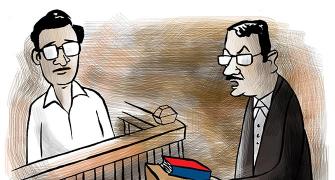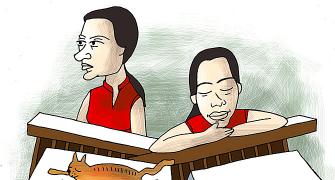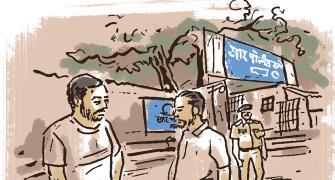‘Bedecked, both days, in variations of pretty pinks and whites, kohl, her hair streaming over her shoulders, a dot of bright sindoor in its parting, Accused No 1 in the Sheena Bora murder case did appear to have a fresh luminosity about her that you imagined seemed to emanate from a happy, secret satisfaction with herself.
‘She had good reasons to be self-satisfied.’
Vaihayasi Pande Daniel reports from the Sheena Bora murder trial.

Illustration: Dominic Xavier/Rediff.com.
Was the Indrani Mukerjea who arrived at the Mumbai city civil and sessions court, south Mumbai, on August 29 and August 30 the same Indrani Mukerjea who left court August 20, hardly a week earlier?
Maybe not.
The newer, end-August ’19 vintage Indrani was “glowing,” as a lawyer astutely commented.
Bedecked, both days, in variations of pretty pinks and whites, kohl, her hair streaming over her shoulders, a dot of bright sindoor in its parting, Accused No 1 in the Sheena Bora murder case did appear to have a fresh luminosity about her that you imagined seemed to emanate from a happy, secret satisfaction with herself.
She had good reasons to be self-satisfied.
The young woman, who hailed from the once-sleepy Sundarpur locality of Guwahati, Assam, where she attended St Mary’s School and Cotton College, went on to become, first, a successful Kolkata and Mumbai HR consultant and then the INX Media “baron” (as she is termed in the press), often apparently making the society pages.
Last week she gained further nationwide fame when her testimony in another case was responsible for the arrest of a powerful former finance and home minister of India, Palaniappan Chidambaram.
The murder accused, with hardly a friend left in the world, had re-invented herself once again
This woman, Avatar 4 of the Pori Bora (of Guwahati days of yore), who swept into court Thursday and Friday had a spring in her step and an insouciance and smugness, that only a survivor like Indrani could own.
But nay, could smugness be too harsh a word?
For all her inscrutable complexities and for all her alleged misdeeds and crimes that she has been charged with, Indrani still radiates a too simple and immature naivete that completely confuses or stumps anyone observing her.
She possesses a kind of do-or-die, audacious bravado that cannot help but make you smile for its brazenness.
Side by side there’s a slightly coarse desire to be the centre of attention, that makes you wince.
But none of it appears scarily evil.
Or she the Sinister Murderess.
Much of the Indian public (as evidenced in social media) might have self-righteously decided back in 2015, when she was arrested, that the allegedly beti-killing Indrani was the kind of Indian woman that they were embarrassed to acknowledge even existed in our fair land. They pronounced her guilty of murder long before her trial began or has concluded and the judge makes his decision.
But as a reporter, like it or not, one gains a more complicated relationship with or interpretation of the subjects one covers in a criminal court.
All accused, no matter their alleged crime, are finally rather unfortunate victims of the system.
It takes years for their cases to come to trial.
And then years for the cases to be concluded.
For years they live in grossly inhuman conditions.
And justice may not be always finally served.
The investigations into the crimes they are said to have committed are often unbelievably shoddy.
Even if the accused might be guilty, the manner (the investigation) through which his guilt is proven, may be unacceptable and lingering doubts about his guilt will always, hence, remain. They finally never get a real or reasonable assessment of their guilt.
So who is the villain here?
The alleged murderer?
Or the cruel system?
The system has no human-ness. Just an inhuman face.
The accused do have faces and even those not yet proven guilty have a human side to them.
One is sharing close quarters, sometimes on a day-to-day basis, with murderers, rapists, larcenists, pickpockets, burglars, drug dealers, blackmailers and other criminals, who come across, frankly, like any other human being.
In this cruel, never-ending space, where time mercilessly stands still, and lives are heartbreakingly on a long pause, the Chief Villain can only be The System, because many a time neither the innocent nor the guilty get a fair say or representation. And also because The System has proven itself to everyone -- you, me, the man on the street -- to be always unrelenting and deceitful.
Hence your powers of observation and judgement will be clouded by this unavoidable truth.
Through the two years plus during which the Sheena Bora murder trial has unfolded in CBI Special Courtroom 51, on the third floor of the court, first before Judge HS Mahajan and then before CBI Special Judge Jayendra Chandrasen Jagdale, the main witness, too, in this case has been The System-spawned Investigation, that has thrown up often the strangest of witnesses. Witnesses that you wonder if they really were witnesses at all.
It is something that Judge Jagdale sagely points out or underlines in a good-humoured, even-handed manner, speaking often about the reliability of witnesses and their memory.
And often angrily, his face like thunder, about how long the accused have already been in jail.
These are the thoughts and conflicting emotions scampering around your head, like a pack of irritating squirrels, as you watch a triumphant Indrani, a prematurely-ageing, tired Peter Mukerjea and a slightly-switched-off-but-always-bravely-smiling Sanjeev Khanna (Accused 2 and Indrani’s former husband) arrive in court for another day of the trial.
Unlike the poorer souls (whose hardship is still far more immense) or the bewildered Africans, that populate the court too, one can relate mildly better to the privations of people like Peter, Sanjeev and Indrani, well because what are the odds that they could have been you or you could have been them?
Thursday was scheduled to be Prosecution Witness 58 Dr Shailesh Chintaman Mohite’s day in the witness box.
That was a non-starter.
The medical report that Dr Mohite of BYL Nair hospital, south central Mumbai, had helped produce in 2015, had not been made available to the defence lawyers. Without that the doctor’s ‘testimony in chief’ could not begin.
Special CBI Public Prosecutor Ejaz Khan promised to have the copies and the witness in the stand by 11.30 am, Friday, August 30.
Meanwhile, Peter and Indrani made another double appearance in the witness box, Thursday, before the proceedings ended, she doing all the speaking.
The various compliances they were working on for their August 30 divorce had run aground. The visit to Syndicate Bank, near Fort, south Mumbai, where they had joint accounts, had not been fruitful because of certain legal complications. Another visit had to be planned.
But before that, would be another hearing in the Sheena Bora murder case on Friday.
Sia Chaudhary and Gunjan Mangla, Indrani’s lawyers, reminded their client that her divorce was scheduled for Friday too.
Indrani immediately said offhandedly they could cancel that.
A shocked colleague whispered something to the effect of, “She is behaving like she is just cancelling a salon or parlour appointment!”
The court corridors were fairly humming on Thursday.
Umpteen television journalists were hanging about outside Courtroom 51, waiting for a fresh bite/quote from Indrani, who had apparently told one television reporter on her arrival Thursday, much to the dismay of her lawyers, that Chidambaram’s arrest was “Good news” and that he would eventually be “cornered” from all sides or four sides.
Television journalists had even apparently reached Arthur Road Jail, south central Mumbai, when Peter was disembarking from the jail truck on Thursday hoping for a view from him.
Suddenly the Sheena Bora trial was hot television news again and Courtroom 51 was being treated like a circus.
Malegaon accused Lt Colonel Srikant Purohit was waiting stoically in the corridors, too, with his three turbaned bodyguards, for Peter’s lawyer Shrikant Shivade, who is also his lawyer.
Stunning news trickled in Thursday of the arrest of a public prosecutor for allegedly asking for a bribe of Rs 50,000 in Courtroom 16 in a forgery case, while the judge was away.
Indrani eventually departed back for jail, Thursday like a maharani with her retinue, still glowing, munching happily on a Rs 10 Cadbury bar brought by her lawyer, generously offering little squares to her police escorts.
When you looked out at Indrani heading to the jail truck you could be forgiven for thinking that she was not going back to miserable, crowded Byculla jail, where a prisoner was killed two years ago, but was just your average Memsahib departing for a sair (stroll) somewhere with bodyguards.
Dr Mohite took the stand closer to 1 pm Friday.
Upstairs Indrani’s lawyer Sudeep Ratnamberdutt Pasbola was arguing pro bono for the bail of the alleged bribe-wanting prosecutor. That courtroom was packed. Lawyers, agog with excitement, filled the room, maybe in support of a member of their black-coated tribe.
Accused Mangesh Arote, wearing a striped purple and black T shirt and jeans had, in his defence, declared he had been set up. But, in spite of Pasbola’s elegant arguments, he didn’t get bail and was sent to police custody.
Downstairs, shortly before Dr Mohite took the stand, Judge Jagdale was explaining to Prosecutor Om Prakash, the CBI prosecutor attached to Courtroom 51, how Arote’s defence could theoretically go. He could suggest that the recording made of him asking for a bribe was merely of him asking for fees, or for money owed toward money borrowed and so on.
Dr Mohite, who looked a bit like one of the Thomson and Thompson pair from Tintin, had a brushy moustache and a very precise, slightly pedantic manner. A short, studious-looking man, wearing a grey checked shirt, grey striped trousers, Dr Mohite brought his very professional demeanour to the witness box.
The professor and head of the department of forensic medicine at Topiwala National Medical College and the attached Nair Hospital, he had been one of the doctors called by the Khar police to in-the-sticks Gagode Khurd, in Raigad district, for the exhumation process of the skeleton said to be Sheena’s, in August 2015. Khar police station, located in northwest Mumbai, began the investigation into Sheena’s murder in 2015 before the CBI took it over in the same year.
Khan, who was conducting Dr Mohite’s testimony in English, started it off by asking about the doctor’s degrees of which there were six or seven.
Dr Mohite has been with Nair Hospital since 1990.
Khan: “Have you dealt with many cases (relating) to skeletons?”
Dr Mohite replied that when he was a student and while he was studying, "examining a skeleton was a routine affair."
Khan asked how many cases involving skeletons had he worked on since.
Dr Mohite: "Five or six cases."
Khan: "In the year 2015 you were called by Khar Police?"
Dr Mohite: "Received a telephonic message from our dean Dr (Ramesh) Bharmal about attending to an exhumation at the request of Khar police (on August 28, 2015).”
Dr Mohite continued: "The name of the place is a bit unusual...”
He halted his testimony to delve into a briefcase lying at his feet mumbling that he wanted to get the name exactly right.
After consulting his papers he came back with: “Gagode Khurd. Was accompanied by Dr Sumedh (Ganpat) Sonavane from the department of anatomy attached to Nair Hospital."
Dr Mohite described that they were taken to the site of the digging at Gagode Khurd by the police. He donned gloves, stationed himself at the edge of the pit and shortly after that the first bone was found.
"One by one, whatever maximum bones could be recovered, were being laid on a white sheet or white paper.”
Dr Sonavane, he confirmed, prepared the list of bones that emerged, right there on the spot. The bones were then handed over to “the police officer that had taken us to the spot” and by evening Dr Mohite had returned to Mumbai.
The next day, August 29, Dr Mohite said they received a further request to examine the bones which he did with a team of doctors from Nair and they subsequently prepared a report. He specified that the skeleton was sent to him in sealed packets and when the report was done they returned the parts.
Waghmare, the tall peon posted to Courtroom 51, somewhere in the midst of the proceedings, took the opportunity to stand on a stool and retrieve a dusty but newish-looking steel grey trunk that had been resting, since the start of the trial, it seems, atop Cupboard No 6.
The trunk was placed on the ground in front of the witness box, near the court clerks and opened up.
A bunch of brown and light green packets bearing the inscription Forensic Science Laboratory, who Dr Mohite corroborated had done the DNA testing, were taken out from within it.
The packets, which were not sealed, made dull thudding sounds as they were, first, placed on the table in front of the lawyers and later shown to Dr Mohite .
Khan puzzled asked: “How is it unsealed?”
Dr Mohite: “Sent in sealed envelopes. Yes, it bears my signature”
Shrikant Shivade in Marathi: “Seal naahin na?”
Dr Mohite, not perturbed: “When I sent it I had sent it in sealed envelopes.”
Judge Jagdale started dictating for the court record that the defence was taking objection.
Shivade cut in: “No objection. We can see with our naked eye that the envelopes are open.”
One by one the packets were lined up. Some were bigger. Some contained several further packets.
Dr Mohite pulled out the contents of the first small brown envelope. It contained a tooth which was in fragments. The doctor pointed this out and mentioned that a larger portion of the tooth had been labelled in blue ink and that the tooth was one of two “Secondary maxillary permanent molars” of the upper jaw.
The tooth, which was wrapped in white filter paper and looked like a handful of crumbled seashells, was then passed around. Shivade has a careful look at it.
The young, sweet-looking court clerk, who one imagined looked slightly queasy with the process, finally placed the pieces back in the envelope, cautious to sweep up some of the shattered remains that had dropped on the desk.
Next, with a loudish clatter, from another open brown lifafa (envelope) came out a large bone in two pieces.
It was the left femur, pronounced Dr Mohite.
The femur is the strongest and largest bone of the human body, incidentally.
The bone pieces were handed to him.
In the back both Sanjeev and Indrani were standing in the accused dock observing the process interestedly. You wondered what thoughts were running through their heads.
Slightly muddy still, four years later, Dr Mohite casually held the grey-white brittle pieces up and joined them together, thoughtfully looking at the reconstructed foot-long femur, examining the pen markings on its “popliteal (rear) surface.”
He could have been handling a long instrument or a ruler, so everyday was his approach.
You could not imagine that this was actually and supposedly Sheena’s femur that we were all looking at.
The thigh bone of the murder victim, had been ignobly tagged with the blandly anonymous name Article 14 FM 578/15, never to be Sheena’s leg again.
Her femur, which along with the rest of her bones, had been living in a dust-cloaked trunk above a cupboard for all these years.
How many bones of other murder victims were in Courtroom 51 or adjoining courtrooms? How long do human remains live on in courtrooms? Long after the case is done, in case there are appeals?
Dr Mohite announced: “In the report in view of (its) features both the femurs belong to one individual and are of a female.”
It was nearly 2 pm and many packets of bones to go.
Would this take hours, days or weeks?
Khan sought a new date, suggesting that Dr Mohite could continue Saturday at 11 am.
Dr Mohite left along with his colleague Dr Sonavane, who had come with him to court, to be back Saturday for more detailed skeleton analysis.
No doubt Shivade, Pasbola and Co, in preparation for the upcoming cross, have located a couple of medical textbooks and a sample skeleton to study in the interim.
Indrani, who was headed to the benches outside Courtroom 51 to sit with her papers and with Radhaji, her advocate and friend, was hauled back into the room by her lawyers with the admonishment, “Don’t go anywhere Indrani!”
Her lawyers then formed a kind of informal cordon around her preventing access from journalists and patiently explained to their client that talking to the press could get her in trouble with the judge and he might order that she observe the trial only by video-conferencing from Byculla jail, south central.
Indrani listened meekly, big-eyed, temporarily put in her place, her lawyers somewhat mollified.
But as she was exiting the court, her police escorts hustling her along, the lively spring was still there in her step.
She radiated high-wattage, perky smiles all around.
It will be difficult to ever forget Indrani Mukerjea, even long after her trial is over.









